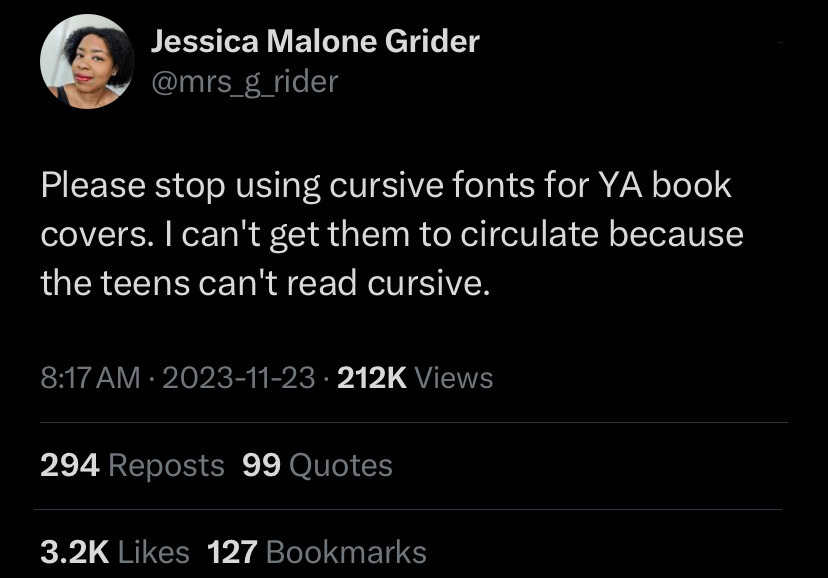this post was submitted on 02 Dec 2023
588 points (94.1% liked)
Microblog Memes
5754 readers
2070 users here now
A place to share screenshots of Microblog posts, whether from Mastodon, tumblr, ~~Twitter~~ X, KBin, Threads or elsewhere.
Created as an evolution of White People Twitter and other tweet-capture subreddits.
Rules:
- Please put at least one word relevant to the post in the post title.
- Be nice.
- No advertising, brand promotion or guerilla marketing.
- Posters are encouraged to link to the toot or tweet etc in the description of posts.
Related communities:
founded 1 year ago
MODERATORS
you are viewing a single comment's thread
view the rest of the comments
view the rest of the comments

Because it's a waste of time, and a lot of people were taught in a way that wasn't the easy, quick way you seem to think it was.
The way they taught me was to write the alphabet in a new script over and over for about an hour a day twice a week for several years. If you had poor handwriting you had to do it more, and you could fail lessons based purely on "didn't shape your cursive S correctly".
Then you leave elementary school and teachers immediately switch to saying they won't accept assignments in cursive, and then in highschool and college they won't even accept handwritten.
Slide rules are also easy to learn, but we don't teach them because there's no point to it.
Welcome to why so many people hate it. You're taught it, it's an awful experience, and then you never use it again.
We may as well teach slide rules and abaci.
Skipping, of course, that cursive is a technical skill and not cultural knowledge.
Cursive lacks technical value, and if there's a pointless technical skill that most teachers seem incapable of teaching maybe the answer is to cut it from the curriculum.
Apart from the fact that EEG and fMRi studies have found great benefits to it. It seems odd to completely remove something from the curriculum because its not being taught well.
That article repeatedly conflates writing by hand and cursive. Those aren't the same thing in all places.
If you read the study, they also get those results from just drawing.
The ability to write by hand is one thing, but learning a second more complicated script that can't be used in many contexts? Why would you want to keep that?
Why do we need two alphabets, one of which can't be used on official paperwork?
I think cursive to you means a very specific old timey alphabet, but it doesn't need to be that exact alphabet to be called cursive.
Drawing also activating the brain is great, but its not going to help you learn the thing you're taking notes on if you draw an unrelated picture! My point is that it's not a completely useless technical skill just because you can't use it on official documents when you're an adult.
The issue is with that exact alphabet called cursive, and needing to be taught two distinct alphabets.
That's literally the part that people are saying we shouldn't do, because in huge parts of the US, that's what people mean when they talk about teaching cursive.
No one is saying to drop teaching handwriting. This entire thing is "teach one style of handwriting", ideally the one that can be used to address letters and matches what we use for every other form of printed media.
The point about the drawing was less that we should have kids do more art, and more that the specific orthographic tradition of cursive is unlikely to be required for the benefits. Normal handwriting is almost certainly sufficient.
Right, I feel like the name cursive is the problem.
As far as I understand "cursive" is generally the term for any joined up writing. The cursive classes that seem to have traumatised a generation of Americans seems to be teaching a specific and overly extravagant alphabet that is more akin to calligraphy. I would definitely agree that calligraphy should be under an art banner and not a requirement.
I think kids should be taught to join up their writing. That's what happens in the UK and it is used for exams and such up until university.
Personally, I don't get the focus on joined up writing, but I'm not opposed to people teaching how to write in an efficient legible manner.
The problem with the word cursive is as you say. Some people mean "handwriting" and some mean "calligraphy".
In the US, cursive is the last example from the first image. I think we should primarily teach the first three from the first image because they match the typographic style used everywhere in our society.
The second image, which claims to be how the UK does it, is acceptable because it's basically print but with standardized "pen drag". I don't see the point anymore to telling people not to lift the pen, but I don't think it's backwards or silly.
A good litmus test came to me while looking for those images: in a good number of handwriting examples people write with joined letters that they can't do cursive at all, and actually can't remember most of the letters.
I think if it gets to the point where you need to remember a second set of letters, and not a method for writing one set of letters, we shouldn't make it a core requirement.